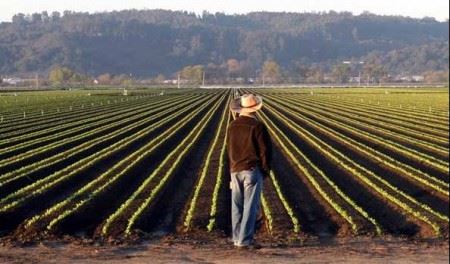California’s agricultural industry, the largest in the United States, is responsible for producing more than one-third of the nation’s vegetables and two-thirds of its fruits and nuts. This $54 billion sector is not just critical to the state’s economy – it’s essential to the global food supply. However, beneath this impressive output lies a worsening crisis: a chronic shortage of farm labor.
Despite offering some of the highest agricultural wages in the world, California’s farms are struggling to recruit and retain enough workers.
According to a variety of federal and state government agencies and private industry sources like employment site Indeed, the average hourly wage for a California farmworker ranges between about $17 – $25 per-hour, depending on the type of work, type of crop and geographical location. Compare this to Mexico, where farm laborers often earn $5 or less per-hour, or in countries like Guatemala and Honduras, where rates can be as low as $1-$3 per-hour. This glaring wage disparity makes it difficult for California farmers to compete globally, while also contributing to labor scarcity at home.
As older workers retire and fewer young people – domestic or immigrant – show interest in agricultural work, the labor gap is widening. Addressing this issue will require a comprehensive strategy that reimagines the future of farm labor in California.
The following are some suggested solutions on ways to address the farm labor problem in California. These are possible solutions rather than the absolute solutions. Most importantly, these ideas or suggested solutions are intended here to bring greater focus on the issue and to stimulate further discussion, leading to action, which is needed today rather than later, in order for California to remain the nation’s top agricultural producing state, as well as retaining its position as an essential contributor to the global food supply.
Reform the H-2A Guest Worker Program
The H-2A program, which allows U.S. agricultural employers to bring in foreign seasonal workers, is widely seen as underutilized and overly complicated. Over the past decade, usage has increased more than 300% in California, but inefficiencies persist. Red tape, delays and high compliance costs discourage many employers.
Streamlining the program is essential. New reforms should:
- Digitize the application process.
- Expand the program to allow year-round agricultural work (currently limited to seasonal).
- Include housing subsidies to help cover employer-provided lodging.
- Increase government-to-government collaboration with countries like Mexico to ensure fair recruitment and safe working conditions.
A modernized H-2A could help stabilize California’s labor supply while maintaining ethical labor standards.
Accelerate Investment in Agricultural Automation
Technology is rapidly changing the face of farming. Robotic harvesters, AI-assisted sorting machines, autonomous tractors and drone-based crop monitoring are becoming more accessible. Companies like Iron Ox and Bonsai Robotics are already piloting systems that can reduce human labor by 30–50% for some crops.
However, automation is capital-intensive, and small- to mid-sized farms are often left behind. The state can help close this gap by:
- Offering grants or low-interest loans for tech upgrades.
- Supporting public-private partnerships that develop and test affordable tools.
- Creating regional training centers to reskill existing workers for tech-enabled roles.
Automation won’t replace every worker, especially for delicate crops like strawberries or lettuce, but it can significantly reduce the strain caused by labor shortages.

Improve Wages, Benefits and Working Conditions
While California’s farm wages are high compared to those in other countries, the jobs remain physically demanding, seasonal and often lack basic benefits. Enhancing working conditions will make these roles more attractive to both domestic and immigrant workers.
Potential policy options include:
- Requiring portable benefits such as health insurance and retirement plans.
- Enforcing labor protections to ensure fair treatment and safety standards.
- Extending overtime laws and sick leave to cover more workers and smaller operations.
Studies show that when employers offer better conditions, turnover drops and productivity rises. Workers are more loyal and farms save on constant recruitment and training.
Foster Labor-Sharing Cooperatives Among Farms
Not all farms need labor at the same time. By pooling resources through local or regional cooperatives, farmers can share workers during peak periods. For example, a berry farm might use a citrus crew when its own crops are dormant, keeping workers employed year-round and reducing labor scarcity.
Cooperatives can:
- Provide stability for workers.
- Allow employers to share administrative costs.
- Improve scheduling, transportation, and housing logistics.
The state can help by offering legal support to establish labor-sharing entities and funding pilot programs in key agricultural regions like the Central Valley and Salinas Valley.
Encourage Crop Diversification and Mechanization
Not all crops are equal when it comes to labor needs. Strawberries, table grapes and lettuce require intense manual labor and frequent harvesting. In contrast, almonds and pistachios can be harvested mechanically and require far fewer hands.
Incentivizing a shift toward crops that are easier to mechanize or manage with fewer workers can reduce pressure on the labor pool. Farmers should not be forced to change what they grow, but targeted subsidies and tax credits could encourage diversification into crops that align with available labor and technology. Key to this working is that the crops to be incentivized must have a strong market so that supply doesn’t end up dramatically exceeding demand.
Push for Comprehensive Immigration Reform
The elephant in the room is immigration policy. An estimated 50-70% of California’s farm workforce is undocumented, and fear of deportation drives instability in the labor market. A permanent solution must involve creating legal pathways for those already working in agriculture.
This could include:
- A path to citizenship or legal residency for longtime farm workers.
- Expansion of temporary work visas.
- National legislation such as the Farm Workforce Modernization Act, which includes earned legal status and H-2A reforms.
Immigration policy is federal, but California can lead by lobbying for pragmatic, bipartisan reform and supporting immigrant families at the state level through legal aid and worker protections.
Promote Local Workforce Development
While it’s true that many Americans avoid farm jobs, local recruitment should not be dismissed outright. With the right incentives, some workers – especially in rural areas – may be willing to take seasonal or part-time roles in agriculture.
Ideas include:
- Signing bonuses and retention pay for local hires.
- Job training partnerships with community colleges and trade schools.
- Creating public campaigns to shift perceptions of agricultural work as dignified and essential.
The goal isn’t to displace immigrant labor but to diversify the sources of agricultural workers in a time of extreme need.
Use Data and AI to Forecast Labor Demand
Smarter planning leads to better outcomes. Farms and regional cooperatives should leverage data analytics to anticipate labor needs months in advance. Tools like crop health monitoring, weather modeling and AI-based harvest projections can help employers to:
- Plan ahead.
- Reduce last-minute hiring scrambles.
- Align labor needs with available supply.
State agencies and university extension services can play a role by offering data tools and seasonal labor forecasts to farming communities.
Solutions: A Shared Responsibility for a Stable Future
California’s agricultural labor crisis cannot be solved by wages or technology alone. It will require a coordinated effort, involving farmers, government agencies, worker advocates, technologists and consumers, to build a system that is equitable, resilient and future-ready.
The path forward is neither easy nor quick. But by reforming visa programs, investing in automation, improving conditions for workers and modernizing how we grow and harvest food, California can remain a global agricultural powerhouse without compromising its values.
It’s time to act – before labor shortages force more farmers to leave fields unharvested and consumers face even higher food prices.







